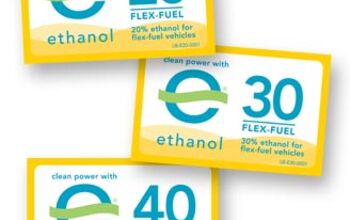E85 Boondoggle Of The Day: Mandatory Flexibility
Green Car Congress reports that an “Open Fuel Standards Act” has been introduced which would require half of all light duty vehicles sold in the US to be flex-fuel capable. The legislation would ramp up requirements to mandate 80 percent flex-fuel capability by 2015. Since ethanol has been running into trouble of late, the industry’s plan now centers on forcing OEMs to bring flex-fuel capability across their lineups, which supporters say will drive greater availability of E85 pumps. The plan would also enable the proliferation of mid-range ethanol blends like E20 and E30, since E85-capable flex-fuel vehicles would also be able to run on the intermediate blends that the ethanol industry so desperately wants to become mainstream. The only waivers for this mandate would be for OEMs who can prove that ethanol fuels prevent plug-in hybrids and other alt-energy vehicles to flunk state emission standards. Meanwhile, as rules are being written for the Renewable Fuel Standard, and a group of Senators are moving to prevent the use of indirect land use change (ILUC) to calculate the total GHG output of biofuels.
The law mandates measurement of “direct emissions and significant indirect emissions such as significant emissions from land use changes, as determined by the Administrator.” And though there are many complexities in attempting to calculate the full impact of biofuels, Senators don’t see this as a challenge to be undertaken, but a baby to be thrown out with the bathwater. The senators “urge EPA to refrain from including any calculations of the ILUC components in determining life-cycle GHG emissions for biofuels at this time. The premature publication and use of inaccurate or incomplete data could compromise the ability to formulate a sound approach to implementing this life cycle GHG emissions requirement in the future. And the resultant rulemaking confusion could seriously harm our US biofuels growth strategy by introducing uncertainty and discouraging future investments.” Oh yeah, and we would have to find new campaign contributors too.
More by Edward Niedermeyer
Latest Car Reviews
Read moreLatest Product Reviews
Read moreRecent Comments
- CanadaCraig My 2006 300C SRT8 weighs 4,100 lbs. The all-new 2024 Dodge Charge EV weighs 5,800 lbs. Would it not be fair to assume that in an accident the vehicles these new Chargers hit will suffer more damage? And perhaps kill more people?
- Akila Hello Everyone, I found your blog very informative. If you want to know more about [url=
- Michael Gallagher I agree to a certain extent but I go back to the car SUV transition. People began to buy SUVs because they were supposedly safer because of their larger size when pitted against a regular car. As more SUVs crowded the road that safety advantage began to dwindle as it became more likely to hit an equally sized SUV. Now there is no safety advantage at all.
- Probert The new EV9 is even bigger - a true monument of a personal transportation device. Not my thing, but credit where credit is due - impressive. The interior is bigger than my house and much nicer with 2 rows of lounge seats and 3rd for the plebes. 0-60 in 4.5 seconds, around 300miles of range, and an e-mpg of 80 (90 for the 2wd). What a world.
- Ajla "Like showroom" is a lame description but he seems negotiable on the price and at least from what the two pictures show I've dealt with worse. But, I'm not interested in something with the Devil's configuration.


































Comments
Join the conversation
"Don’t use my tax money to pay for the research or infrastructure of E85. Look for venture capital. If no one is interested, probably it’s a bad idea. If someone invested and earned big, good for him." You do know that the Internet and GPS technology both started as government funded projects, yes? To this day, GPS receivers rely on signals provided gratis by the US government's network of GPS satellites.